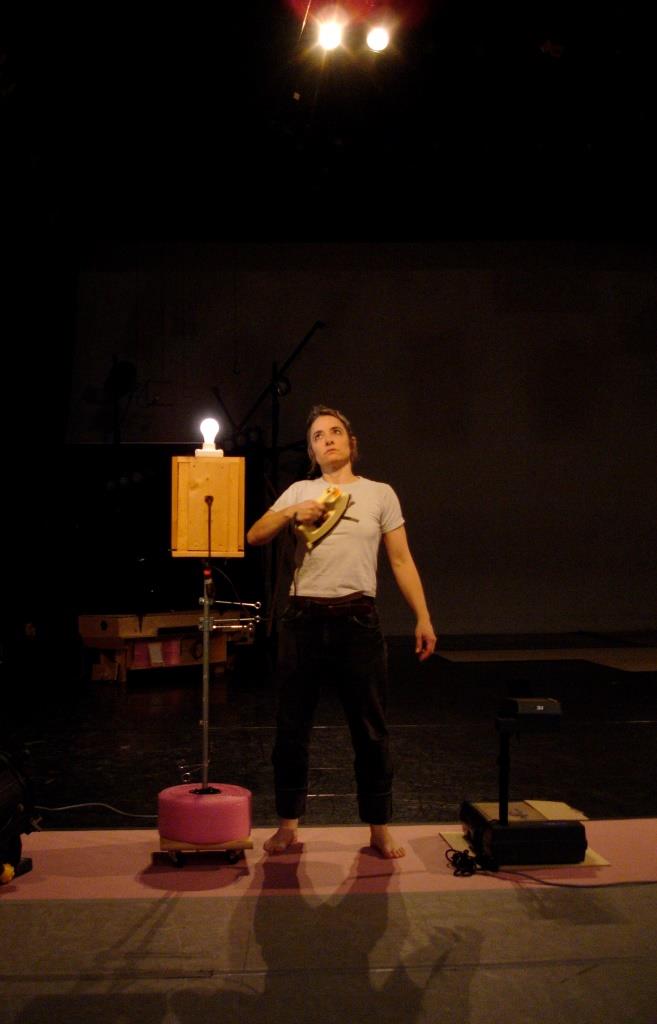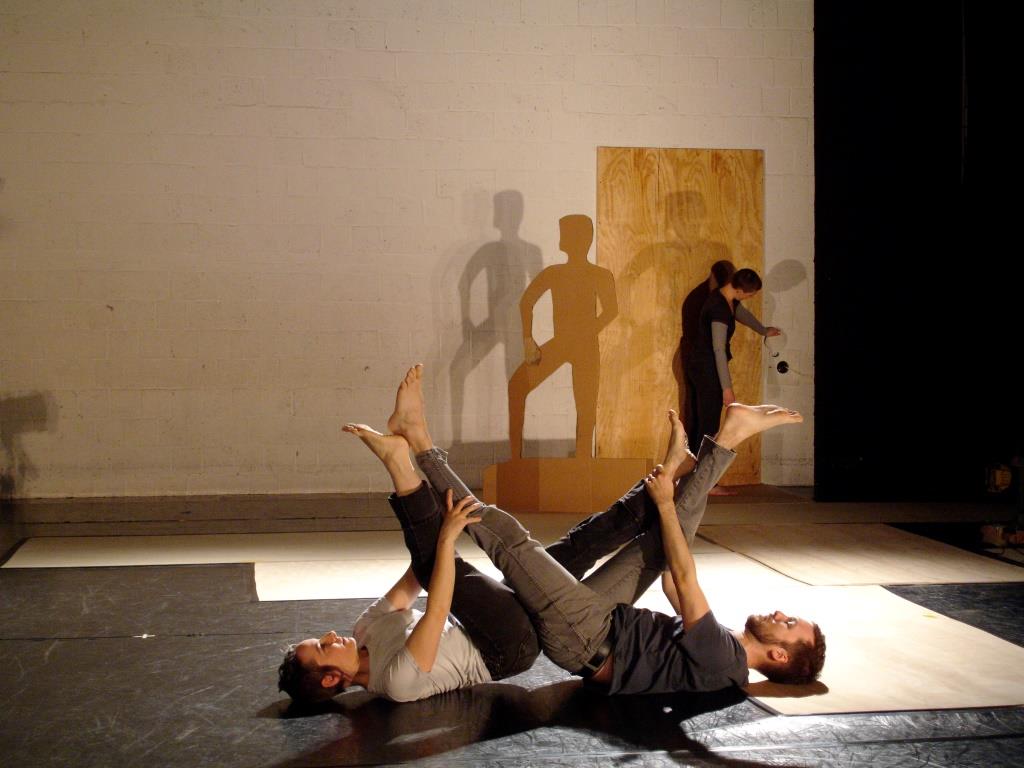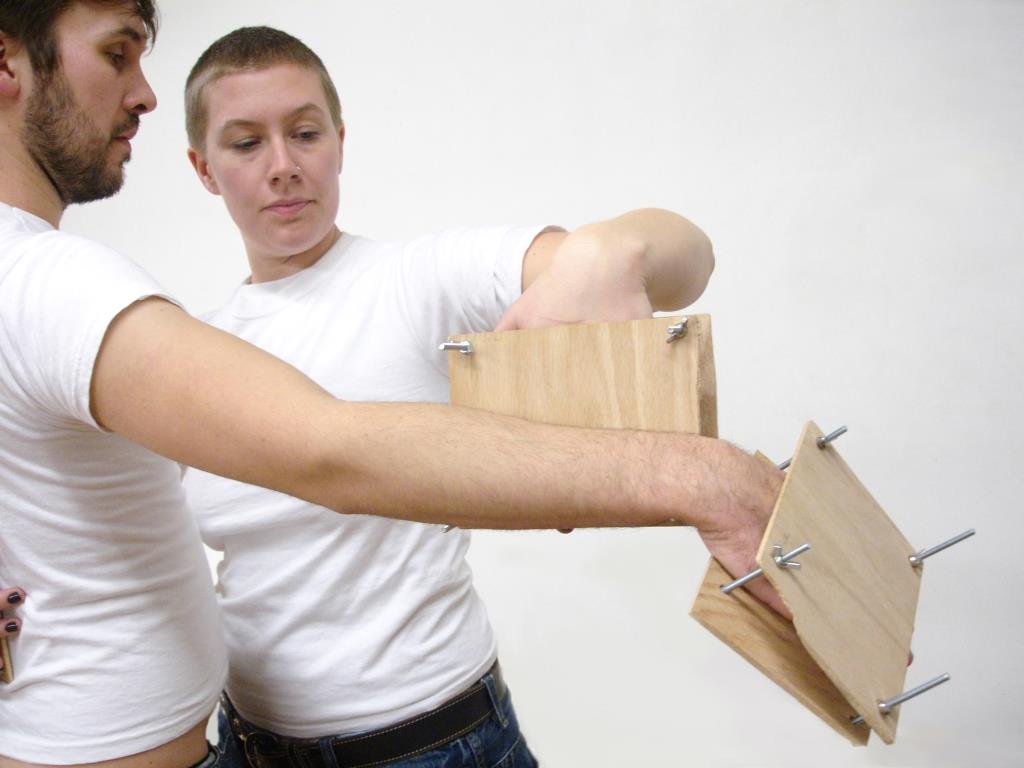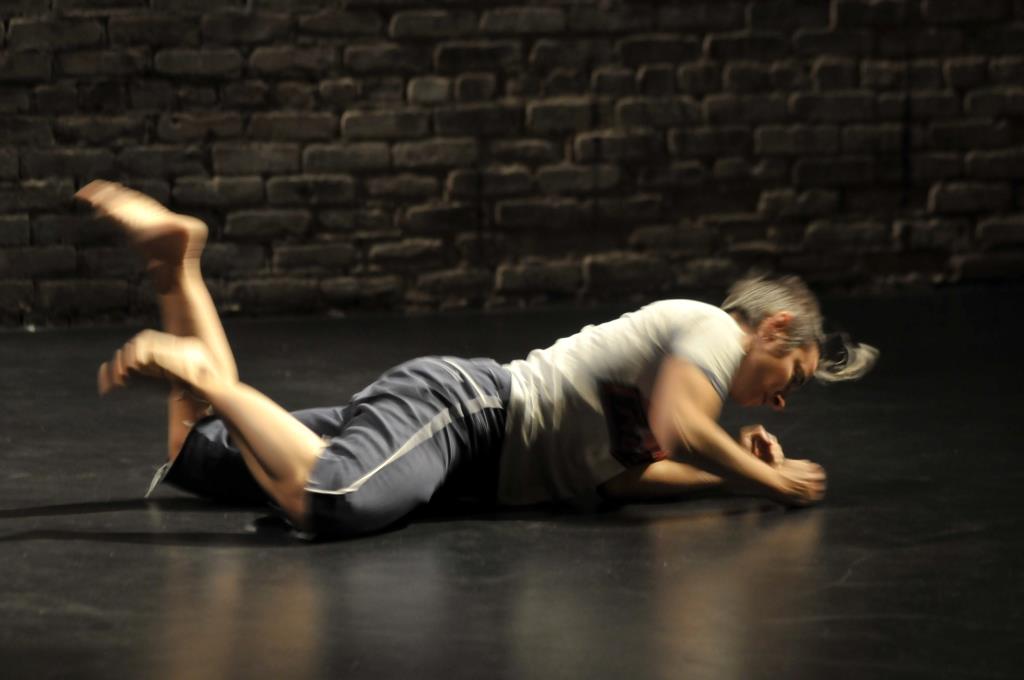Being Karen Sherman
Lightsey Darst interviews polymath artist and dancemaker Karen Sherman whose show, "One with Others," makes a Twin Cities stop on its national tour this week.




WHEN I ASKED FOR THE NEWS FROM MINNEAPOLIS A MONTH OR SO AGO, Mad King Thomas told me about Karen Sherman’s smash hit performance as the host of the Sage Awards. They retold her jokes—her opening salvo poking at the lack of “movement coaching” for Sage hosts—and recounted her antics: how she repurposed an army blanket from Shapiro & Smith for her costume change. Whatever she did, Sherman bowled everyone over; no one mentioned the evening’s winners.
This was at once a surprise and no surprise. Anyone who’s heard Sherman speak, or seen her work, or read her Facebook posts knows she’s sharp. And yet something private about her—her tightly-wound physicality, maybe, or that startled way she has of looking out of the corners of her doe eyes—suggests the polar opposite of a person who would want to get on stage with a microphone and entertain a crowd. Established, awarded, well-respected, Sherman nonetheless comes off as an underdog.
I’ve been puzzling over Sherman for a while—as a personality, an artist, a thinker. An in-progress showing of her new work One with Others (at 9 x 22 in January 2012) didn’t floor me at once, but it went on the slow burn in my mind, images from it cropping up here and there in my poetry, in my reactions to news. Where her previous pieces felt solid, like a wrecking ball, One with Others had the eerie familiarity of a dream I might have had—or might yet have in a some unforeseeable but not too distant future.
If I’m not mistaken, Sherman’s underdog status has subtly shifted since she first appeared on the Minneapolis performance horizon; she now seems closer to the center of conversations about identity, pain, making, closer to everyone’s dangerous (or dangerously funny) dreams. In this light, her completed One with Others, stopping this week in Minneapolis on a national tour, seems poised to be one of the hottest shows of the year.
Below, a conversation with her. We started out talking about the earlier 9 x 22 showing of this new work, in the course of which she made a provocative statement:
Karen Sherman
I’m not sure that much of any of that material is still in the piece. Funny. But yeah, regardless, how things get made is often more interesting than what gets made, anyway.
Lightsey Darst
I like this! It strikes me as (a) true and (b) heretical. If you’re an artist, you have to be interested in process, I think. (Someone would probably disagree. Someone always does. But I suppose many people think artists say too much about their “process”.) But you mostly cannot tell an audience that your process is more interesting than what’s on stage. Or is the audience’s version of the experience the concentrated quickie version—of necessity, not as lastingly interesting as the process? What is the process?
Karen Sherman
Well, no, I’m not saying that one should tell an audience that the process was more interesting than the product. Only that interesting processes do not always yield interesting end results. I think sometimes an artist is so attached to / smitten by the process that they fail to see that what came out of it needed something more to make it interesting to the rest of the world. What artist hasn’t experienced this, really?
Lightsey Darst
What is the ‘something more’? I wonder, myself, about a sort of distinction I feel in my work, between process (ongoing, internal, recursive, pleasurable) and “finishing” (outward-oriented, deadline-driven, stressful/exhilarating). About the process, I feel fairly confident, but “finishing” has a down-and-dirty feel. . . and maybe finishing also implies some betrayal of process, or of the result of process.
Karen Sherman
There’s certainly the external deadline thing that comes up, but I am referring more to the fact that art (most of it, anyway and dance, certainly) eventually gets an audience, and the question: What is it you want to be saying with/to an audience (as opposed to only your own self)? I have heard some artists say things to the effect of, “as long as I believe in it, the audience will believe in it,” as if self-conviction is a perfect spell you can weave upon another person. I think art that doesn’t believe in itself is probably going to be bad, but just because art may believe in itself, doesn’t automatically make it good—or even legible. I just think there is always more work to do to make something legible. I mean, if your house has “good bones” but it’s cluttered and cold and your furniture doesn’t fit, you probably won’t be able to sell it. Or make anyone want to come over.
“Finishing” doesn’t feel down and dirty to me. It feels more (at least on a good day) like tightening the screws and fine-tuning the engine. I guess that’s how it feels in tech or the final week or so. The last month or two is, for me, usually crying jag time.
_____________________________________________________
Next, I asked Sherman about how she uses showings and how she deals with criticism.
Karen Sherman
Dance is lucky, in some ways, in that work-in-progress showings or feedback sessions are relatively encouraged. If you have smart, honest people talking to you after those showings, they can reflect what the work has become outside of your intention for it. They can help you kill your darlings.
Lightsey Darst
Do you have a critical core? Are you in someone else’s critical core? Is taking criticism a crucial skill for choreographers? How do you do it?
Karen Sherman
I always have at least one big rehearsal-showing type of thing, where I ask for feedback. There are several people I tend to ask to come no matter the project—colleagues who are super smart, articulate, or who are super familiar with my work—but I also always try to ask people who have never done that with me before or who aren’t artists (or at least aren’t dancemakers), or who make very different dance than I do, or who don’t know my work, etc., etc. I guess I try not to surround myself with yes-men. Taking criticism seems a crucial skill, but it’s not necessarily easy. I guess one thing I’ve tried to do—especially with those invited showings— is to set up a way to have a real conversation afterward. There are some protocols that prohibit talk of “like or dislike” or that do not allow the artist to ask questions in the moment (i.e., to interject with a question in order to get clarity). Often, there is a dedicated time for the artist to speak. These aren’t unhelpful, exactly, but for me personally, I get WAY more out of a dynamic conversation—where I can ask questions back right away in order to better understand what the person is saying. Or even to get at deeper ideas. This almost always makes the feedback person go deeper or get more specific about what they experienced. I think everyone benefits from that. Most of my most trusted colleagues will tell me they liked or didn’t like something, even if that is taboo language. Sometimes they’ll tell me something in a way that makes it hard to discern whether they are saying something positive or negative—I think this happens ALL THE TIME in the dance world — this polite, almost passive-aggressive critique (or maybe it’s just an MN thing)—and I’ll just ask if they are saying it was good or bad, something they liked or disliked. I think this kind of talk can be helpful if it’s within a larger, more rigorous critique. All that being said, I also of course feel great if someone just likes something!
_____________________________________________________
I asked about how she creates her art, because she uses words and carpentry as well as dance. Also, I was particularly curious about a notable image I remembered from the 9×22 showing: a clamp that framed and disabled a dancer’s hands.
Lightsey Darst
I wonder when you work. I envision you hunched over a work table in the basement at 2 am, inventing those wicked little hand-presses (they made it into the completed show, right?). I loved them. They call to mind botany (flower press), torture, wood-working, medicine maybe (a sort of cast), something pervy too. How did those little things come about?
Karen Sherman
I like the botany image. I hadn’t thought of that so directly but it of course makes sense. And the cast imagery—that’s nice, the idea of setting the broken pieces. I mean, I do think of the hand presses as binds and prosthetics, inhibitors, augmenters. They hide the hands completely and so make them even more visible. They suggest sensation, as in a torture sense, yes, but also potentially make you long for touch. With them on, you cannot write, you cannot feel someone else, two things that are so important in the piece. They initially came about simply as a stand-alone image. I just imagined them one day and decided to make them. I wasn’t sure what we’d do with them dance-wise. I just followed an instinct and made them. All of the objects came about that way. I often like to make or work on things or read about subjects that seem, on the surface, unrelated to the dance at hand. Sometimes those pursuits seem like a clear respite from dance, a place to deal in the concrete and tangible as a relief from the abstractions of dancemaking. But by now I know myself as an artist well enough to know that those other pursuits or interests almost always, in the end, have everything to do with the dance. It’s a side door, another way to make the dance, or elements of it, or a place to expand upon ideas. I think I would circle the drain if I tried to do it all through dance. (Well, I have tried that in the past to varying degrees of satisfaction, I guess, but I really like making all kinds of stuff.)
I just came back from a two-week workshop at the Haystack Mountain School of Crafts in coastal Maine. It was essentially a carpentry sculpture workshop, I guess you’d call it. This particular session’s instructor, Katie Hudnall, makes fascinating work, and I was drawn to how a lot of it seemed in conversation with some of the pieces I made for One with Others. The pieces I made for One with Others were “for” the body far more than her work is, but she had a way of talking about how to work in the woodshop (including safety practices) that explicitly dealt with proprioception and the senses, how to move with the equipment, how to listen to it. At one point she asked that even if we had previous experience with the equipment, to work with it her way so that she could look at any one of us from across the shop and assess our safety simply by reading our body language. It was a thrill to hear a woodworker talk that way because it reflected my own relationship to working in the shop (through my body) and a kind of holistic sensitivity on her part. Hers is a sensual way of being with material and in a building process that is generally seen as rough, inelegant. But of course, it’s highly sensitive [work]. The way you can feel your material is about to crack isn’t all that different than knowing how to handle another person’s body.
In Maine, I generally spent about 12-15 hours in the shop each day and some of the other students started teasing me, making comments about how I never seemed to leave. I was working on some ambitious projects, and maybe I also worked more slowly, I don’t know. . . but I think it was more that it is really no big deal at all for me to put in a 16 hour day in a theater, either as an artist or as a stage technician. It’s just what I’m used to, at least in concentrated, week-long chunks. I’ve been saying for years that the analog, starting-over-every-time nature of dancemaking can be Sisyphean or frustrating (or even sometimes alluring). How you have to have everyone there, everyone has to warm up and try to remember what they did last time, etc. By the time that’s all done, rehearsal is almost over. The progress is so slow. When you leave the woodshop and come back the next day, the pile of lumber is as you left it, even if your perspective on it or plan for it has changed. At a certain point at Haystack, I wondered if I would tire of the static nature of my materials. I didn’t. I appreciated that I could stare and stare at the problem before me and try to figure out a solution. I could leave and go eat or sleep on it overnight and come back and scry over it again. It’s hard to do that in the same way with dance because if you’re in the piece, you can’t really watch it and looking at video is always unsatisfying and false. But dance offers other ways to work out its problems. The minutes or hours I lay awake in bed at night are often when that happens. The ideas that come then are often better in that half-dream state than they end up being in the studio. At least you have a lead, a place to wander away from, the catapult, the wormhole. Eventually, it all seems to converge again.
I love making dances, torturous as the process can sometimes be. I feel very lucky to like to make things in multiple mediums. too, though; and I feel very in touch [interdisciplinary interest] with that right now.
Lightsey Darst
I love that you went to a carpentry sculpture workshop. How did that come about? What did you make?
Karen Sherman
My friend Dan Hurlin told me about Haystack and some time after, I got it in my head that I was ready to take another class in woodworking or some kind of visual construction, because I was doing so much of it for this piece. I wanted to take a blacksmithing class, actually, to make custom hardware to go with the wooden things I was making. I basically wanted a little residency in something like this. I looked at Haystack and what they were offering was a perfect fit with my interests. I got a Jerome Travel Study Grant to go. I made some reliquaries (we started with that idea, and I made one or two more after that), a lamp or two (I had already been making lamps this year). Most of the things I made had to do with wood and light. I also decided I wanted to learn how to do some simple mechanical joinery (e.g., dovetails, butterfly joints), which wasn’t part of the focus of the class at all, but I ended up incorporating them into something I made. I laughed at myself because I ended up then making probably several dozen butterfly joints and was getting pretty sick of them! This is the class I took (if you click through, scroll down to Wood):http://www.haystack-mtn.org/summer_workshops_session3.php
Lightsey Darst
I’m going to ask a big or maybe obvious question: Why is it dance that you come back to? Did it choose you or did you choose it? You write here in what strikes me as a very mature way about the difficulties and pleasures of various forms; I get no sense of envy or romance (about being another kind of artist, about being a dance artist).
Karen Sherman
The way I sometimes have put it is: dance won in my battle with it. I belong to it and it to me. This is because after 20 years of doing dance, I understand it and speak it and it has become essential, not only to what I make art-wise, but to how I live, how I see the world, how I read people. I also am aware that I was predisposed to some of those things—not to technique or anything like that, but to using my body and to feeling what it is to be alive in a room with other people, reading the signals. [I’m also drawn to] the ways dance employs all other art forms (visuals, sound, music, words, craft, fiber, etc.) in its deployment. Anything can potentially be essential.
That thing about thinking other artists have it better. . . I joke about it sometimes, but really, I just think it’s all different. I usually say that the only people who have it worse than dancers are poets, though, so there’s that. . .
_____________________________________________________
We concluded with chatting about a certain phrase from her favorable Washington Post review: her work, the headline notes, “gleefully mocks artistic hooey”.
Lightsey Darst
Re: artistic hooey, I’ve been thinking lately about how artists are not real for a lot of people. There’s this idea that exists (I hate to write so vaguely, but it’s so hard to assign any agency to this) that artists do not pay taxes, artists do not work, artists do not think about what to get at the grocery store or how to get a car tail light fixed. These are real problems, and art problems are not real problems, so artists should not talk about their lives. . . I sound bitter, I know. But I just read a book of poetry that was basically aimed at PhDs in cultural theory, and I thought why not? There are plenty of PhDs in cultural theory. God knows they could use poetry as much as anyone else.
Speaking of which, One with Others is also a book of poetry by CD Wright; any connection?
Karen Sherman
The artistic hooey. . . yeah, I wasn’t crazy about that. It was a little reductive and cute. One with Others certainly grapples with some of that kind of thing— being an artist, or being a person amid the trappings and pitfalls of what comes along with making art—but it deals with so much else. And the “being an artist” aspect of the piece isn’t separable (in my mind) from the parts of the piece that are about being a person, about intimacy, and the tangles of having to just exist next to someone, or within an identity or in an action. So much of the art we make is unavoidably about that, to some degree, since we make it and others consume it. At least, this is one very shaky stance on that.
But to come back to the WP review, that’s sort of what made it interesting to me. As far as reviews go, it was largely what you hope for—someone who can see the good and the not so good in a piece and not be overly swayed by one or the other. [You want a reviewer] to see the whole. There aren’t many dance writers (or venues for their work) who consistently write their own art in response to yours, but there are some and when you can get that exchange with them, it’s great. “Artistic hooey” was a disappointing shorthand, but it kind of made me laugh. We had a lot more fun with re-reading how we were each described—that’s always the (chafing) rub. The indignities that come with being the live representation of your art!
As for One with Others, the book—I indeed know about it and, in fact, there is a whole reference to it in the show. Ironically, the current version of that reference does riff on the “other artists have it better” deal (and the other artist is a poet, in this case!). I might revise that part—the artistic jealousy/poutiness—partly because I don’t actually feel that. But art doesn’t always have to be truthful, does it?
_____________________________________________________
Related performance information:
One with Others will take the stage at the Red Eye in Minneapolis November 7 through 9. Find specific show times and ticket details: http://www.redeyetheater.org/event/karen-sherman-one-with-others
_____________________________________________________
About the author: Originally from Tallahassee, Lightsey Darst is a poet, dance writer, and college instructor. Her manuscript Find the Girl was recently published by Coffee House; she has also been awarded a 2007 NEA Fellowship. She writes a regularly on a variety of subjects for mnartists.org.